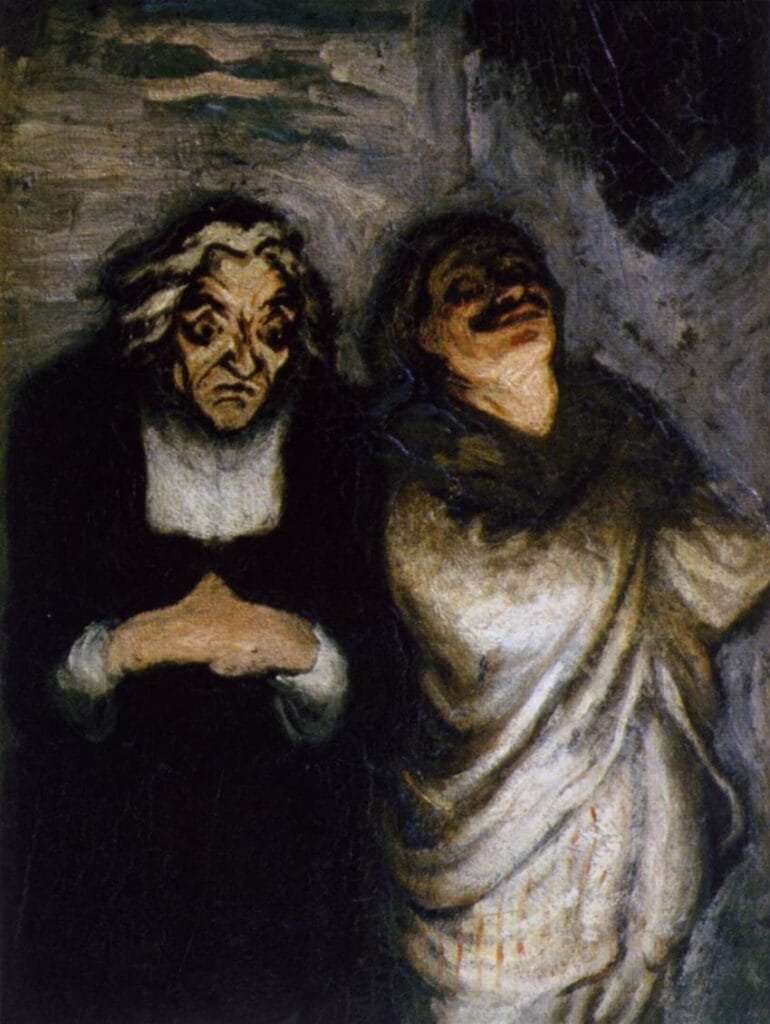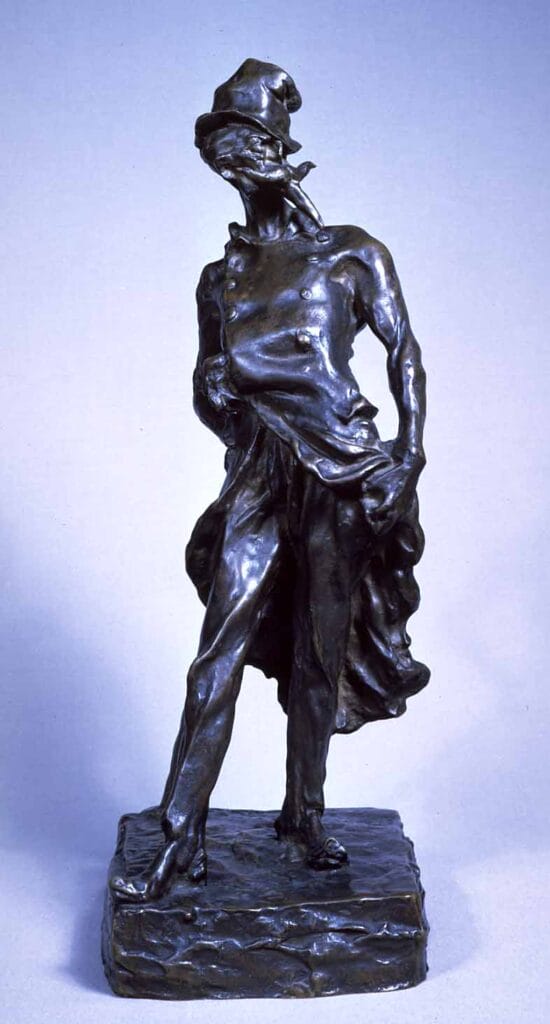Honoré Daumier, born in 1808 in Marseille, France, and passed away in 1879, was a prolific artist, painter, and sculptor. He was widely known for his thought-provoking caricatures and political cartoons, which were published in various newspapers and journals. His works critiqued the social and political issues of his time, and Daumier’s keen observations and biting wit made him a formidable force in the art world. This article aims to provide an in-depth exploration of the artistic genius of Honoré Daumier, his unique artistic style, the influence of satire in his work, and his enduring impact on the art world.

Early life and artistic beginnings
Daumier was born to a working-class family, and his father was a glazier and an aspiring poet. His family moved to Paris in 1816, where Daumier received his early education in art. Initially, he trained in the Académie Suisse and later under the guidance of Alexandre Lenoir, an archaeologist and art historian. Daumier’s talent quickly caught the attention of Charles Philipon, a writer and publisher, who hired him as a lithographer for his newspaper, La Silhouette.
In 1830, Daumier began working for Philipon’s new publication, La Caricature, where he created political caricatures of the French government, including the unpopular King Louis-Philippe. His biting satire and provocative imagery led to his arrest in 1832, and he was imprisoned for six months. Undeterred by this setback, Daumier continued to create politically charged artwork, and his reputation as a talented and fearless artist grew.

Daumier’s unique artistic style
Honoré Daumier’s artistic style was heavily influenced by his training and exposure to various art forms. As a lithographer, he mastered the use of bold lines, expressive shading, and dynamic composition. His ability to convey complex emotions and social commentary through caricatures and cartoons was unparalleled.
Daumier’s paintings and sculptures also showcased his unique style, which was characterized by loose brushwork, strong contrasts of light and shadow, and an emphasis on the human figure. His works often depicted ordinary people in everyday situations, reflecting the social and political realities of his time. Despite the often grim subject matter, Daumier’s art was infused with a sense of humanity and empathy for his subjects.
The influence of other artists, such as Francisco Goya and Gustave Courbet, can also be seen in Daumier’s work. Like these artists, Daumier was driven by a desire to expose the harsh realities of his time and give a voice to the disenfranchised and marginalized members of society.
The influence of satire in Daumier’s work
Satire was a defining element of Honoré Daumier’s art, and he used it to great effect in critiquing the social and political issues of his time. His biting wit and keen observations allowed him to expose the hypocrisy and corruption of those in power, making his work both entertaining and thought-provoking.
Daumier’s satirical works often focused on the injustices faced by the working class, the excesses of the bourgeoisie, and the failings of the French government. His caricatures and cartoons were not only visually striking but also deeply insightful, offering a glimpse into the heart of French society during the 19th century.
The power of Daumier’s satire was such that it often led to controversy and even legal trouble. Despite the risks, he continued to create fearless, unapologetic works that challenged the status quo and pushed the boundaries of artistic expression.

Daumier’s impact on political and social commentary in art
Honoré Daumier’s impact on political and social commentary in art cannot be overstated. His fearless approach to satire and his willingness to confront the powerful and influential figures of his time inspired a generation of artists to use their work as a platform for voicing their opinions and challenging societal norms.
Daumier’s influence can be traced through the works of numerous artists who came after him, including Georges Rouault, Otto Dix, and George Grosz. These artists, like Daumier, used their art to expose the darker aspects of society and provoke thought and discussion. In doing so, they helped to establish a tradition of socially engaged art that continues to this day.
Daumier’s impact on political and social commentary in art goes beyond his influence on individual artists. His work helped to pave the way for the rise of modern art movements such as Expressionism and Social Realism, which also sought to address social and political issues through art.
Major works and series by Honoré Daumier
Throughout his career, Honoré Daumier created an impressive body of work, including paintings, sculptures, and thousands of lithographs. Some of his most well-known series and major works include:
- Gargantua: This lithograph, created in 1831, depicts King Louis-Philippe as a grotesque, gluttonous figure, gorging himself on the wealth of the French people. The image was so controversial that it led to Daumier’s arrest and imprisonment.
- The Third-Class Carriage: This painting, created in 1862-1864, is a poignant portrayal of a group of passengers in a crowded train car. The work highlights the stark contrast between the lives of the working class and the privileged elite during the 19th century.
- Rue Transnonain: This lithograph, created in 1834, was a response to the brutal suppression of a worker’s uprising in Paris. The image depicts the aftermath of the violence, with the lifeless bodies of the victims strewn across a blood-soaked room.
- The Legislative Belly: This series of lithographs, created between 1832 and 1835, satirized the members of the French National Assembly, portraying them as greedy, incompetent, and self-serving.
- The Sculptor Series: This series of paintings and lithographs, created in the 1870s, depict sculptors at work in their studios. These images provide a rare glimpse into the creative process and the challenges faced by artists during Daumier’s time.

The legacy of Honoré Daumier in the art world
The legacy of Honoré Daumier in the art world is immense and far-reaching. His fearless approach to satire and his relentless pursuit of social justice through his art has inspired countless artists who came after him. Daumier’s influence can be seen in the works of numerous painters, sculptors, and printmakers from the 19th century to the present day.
Daumier’s impact on the art world goes beyond his influence on individual artists. His work also helped to pave the way for the rise of modern art movements such as Expressionism and Social Realism, which sought to address social and political issues through art. Today, Daumier’s work continues to be studied, admired, and celebrated for its powerful imagery and its enduring relevance.
Contemporary artists inspired by Daumier
Honoré Daumier’s influence can be seen in the works of many contemporary artists who, like Daumier, use their art to address social and political issues. Some notable examples include:
- Kara Walker: An African American artist known for her powerful and provocative silhouettes, which explore themes of race, gender, and history.
- Banksy: A street artist whose satirical and subversive works often address issues of war, capitalism, and consumerism.
- Sue Coe: A British-American artist whose graphic and unsettling works focus on animal rights, environmental issues, and social justice.
These contemporary artists, like Daumier, use their art to provoke thought, challenge societal norms, and inspire change.

Visiting Daumier’s works in museums and galleries
For those interested in experiencing the genius of Honoré Daumier firsthand, his works can be found in numerous museums and galleries around the world. Some notable institutions that house Daumier’s work include:
- Musée d’Orsay, Paris, France
- The Metropolitan Museum of Art, New York, USA
- The Art Institute of Chicago, Chicago, USA
- The National Gallery, London, UK
- The Louvre, Paris, France
These institutions offer a unique opportunity to view Daumier’s work up close and gain a deeper understanding of his artistic vision and the impact ofhis work on the art world. Many of these museums and galleries also offer guided tours and educational programs that provide further insight into Daumier’s life and career.

The enduring genius of Honoré Daumier
Honoré Daumier was a visionary artist whose work continues to inspire and challenge us today. His fearless approach to satire and his unwavering commitment to social justice through his art have left an indelible mark on the art world.
Daumier’s unique artistic style, his use of satire, and his impact on political and social commentary in art have influenced generations of artists who have followed in his footsteps. His major works and series, including Gargantua, The Third-Class Carriage, and Rue Transnonain, continue to captivate and provoke audiences today.
For those interested in experiencing the genius of Honoré Daumier firsthand, his works can be found in numerous museums and galleries around the world. Visiting these institutions offers a unique opportunity to view Daumier’s work up close and gain a deeper understanding of his artistic vision and the impact of his work on the art world.
Honoré Daumier’s legacy in the art world is a testament to his enduring genius and his unwavering commitment to using his art to shed light on the complexities of society. His work continues to inspire and challenge us today, and his contribution to the art world will undoubtedly be felt for generations to come.
